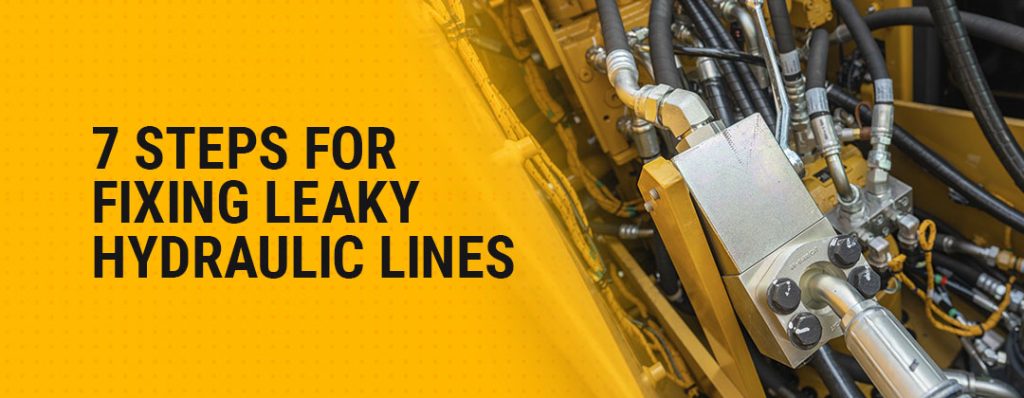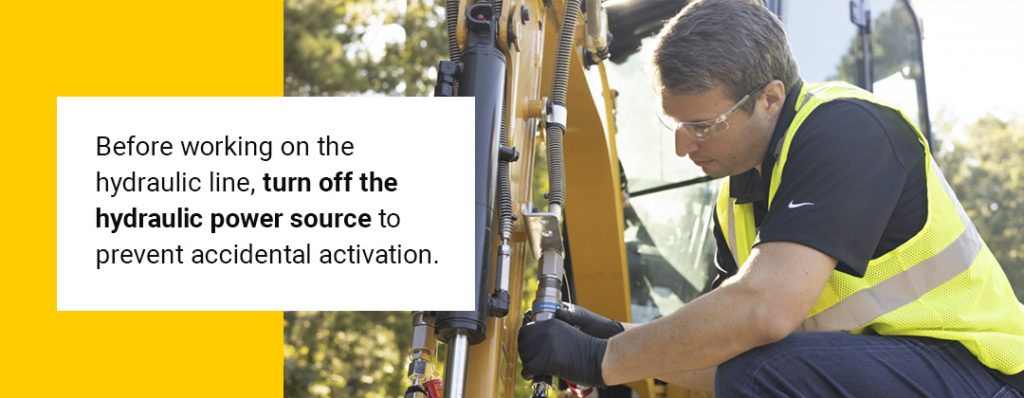
Picture this — you’re in the middle of a critical operation, relying on your heavy equipment to get the job done efficiently. Suddenly, you notice a hydraulic leak, disrupting your workflow and potentially jeopardizing your project’s success. In such a crucial moment, you need a solution to quickly address the issue and get your equipment back in action.
Leaky hydraulic lines can bring any project to a halt, causing downtime, productivity losses and even safety concerns. The team at Gregory Poole understands the urgency and importance of learning how to fix a leaky hydraulic line effectively and resolve it efficiently.
Detecting a leaky hydraulic line at the earliest stage prevents further damage and ensures the efficient operation of the hydraulic system. Here are some telltale signs that can indicate the presence of a hydraulic line leak:
A compromised hydraulic line poses safety risks to operators, bystanders and equipment. Leaking fluid can create slippery surfaces, leading to accidents or injuries. Additionally, hydraulic fluid is often pressurized and a sudden failure due to a leak can result in uncontrolled movements or equipment malfunctions, jeopardizing safety.
Neglecting hydraulic line leaks can also lead to more extensive damage over time. Unresolved leaks strain the system, potentially causing component failures or even complete system breakdowns. The resulting repairs can be significantly more expensive than the initial repair of a leaky line.
Is there a way to repair a hydraulic line? Repairing a damaged hydraulic line is generally not recommended due to hydraulic systems’ high pressure and critical nature. Hydraulic lines are often subjected to extreme pressures and require precise manufacturing processes to ensure their integrity. Therefore, replacing a leaky hydraulic line with a new one that meets the system’s specifications is best practice. Follow these steps to address a faulty hydraulic fluid line.
Before starting any repair work, prioritize safety. Wear appropriate personal protective equipment (PPE), such as safety goggles and gloves, to protect yourself from hydraulic fluid and potential hazards. Identify and address any potential risks associated with the repair process, such as high-pressure fluid or heavy equipment.
Thoroughly inspect the hydraulic system to locate the source of the leak. Look for fluid drips, puddles or stains that indicate the compromised area. It’s essential to pinpoint the exact location of the hydraulic leak to ensure an accurate repair.

Before working on the hydraulic line, turn off the hydraulic power source to prevent accidental activation. Next, drain excess fluid from the system to minimize potential spills or contamination. Isolate the affected hydraulic line to prevent fluid flow during the repair process.
Carefully loosen and remove the fittings that secure the damaged hydraulic line. Use appropriate wrenches or tools to avoid damaging the fittings or surrounding components. Ensure the hydraulic system is adequately supported to prevent strain or accidental movement during removal.
Obtain a suitable replacement hydraulic line that matches the specifications of the original line. Ensuring compatibility with the hydraulic system’s pressure ratings, size and fittings is crucial. If necessary, acquire any additional fittings or adapters for proper installation.
Thoroughly clean the fittings and connections before installing the new hydraulic line. Apply an appropriate sealing material, such as thread sealant or O-rings, to ensure a tight and leak-free connection. Carefully tighten the fittings to the recommended torque specifications using a torque wrench, being mindful not to overtighten.
Once the new hydraulic line is installed and all connections are properly sealed, restore the hydraulic power to the system. Conduct a thorough inspection, checking for any signs of leaks, unusual sounds or abnormal pressure levels. Operate the system and verify it functions correctly, ensuring smooth and efficient operation.
A patch can be employed as a temporary hydraulic hose repair. However, this solution is intended only for short-term use until a proper replacement hose can be obtained. Hydraulic systems operate under high pressure and require durable, leak-free components for optimal performance and safety.
Start by identifying the location of the pinhole and ensuring the area is clean and dry. Utilize a hydraulic line repair kit specifically for patching pinholes, typically including epoxy putty or resin. Mix the components according to the manufacturer’s instructions and apply the material directly over the pinhole, ensuring complete coverage.
Allow sufficient time for the epoxy putty or resin to cure, forming a strong seal. Once the repair is complete, test the hydraulic line for any signs of leakage. Remember that this is a temporary fix, and replacing the hydraulic line should be a priority.
When fixing a pinhole in a hydraulic line, prioritize safety and seek the most effective solution. While temporary patching can provide a short-term fix, it is advisable to call a professional for hydraulic repairs. With over 70 years of experience in the heavy equipment industry, Gregory Poole Equipment Company has established itself as a trusted partner for hydraulic repair and maintenance needs. Our skilled and knowledgeable technicians are well-equipped to handle any hydraulic issue, ensuring your equipment is back on the job site with optimal performance.
By relying on Gregory Poole Equipment Company, you can benefit from comprehensive services tailored to meet your specific requirements. Our hydraulic shop offers full-service hydraulic repairs on all Cat® products and repairs on pumps, cylinders and motors of non-Cat brands. Additionally, we provide pickup and delivery services across Eastern North Carolina, along with a complimentary disassembly and quote process.
Choosing Gregory Poole Equipment Company means you receive more than just exceptional service. We stand behind our work, offering a 6-month warranty on all repairs. This demonstrates our commitment to quality and customer satisfaction, giving you peace of mind that your hydraulic issues are in capable hands.
While temporary fixes may address immediate concerns, the expertise and resources of Gregory Poole Equipment Company ensure that your hydraulic system is properly diagnosed, repaired and maintained for long-term reliability.
When it comes to hydraulic repairs, make the wise choice by reaching out to Gregory Poole Equipment Company. Benefit from our extensive experience, comprehensive services and unwavering commitment to providing cost-effective solutions for all your hydraulic needs.